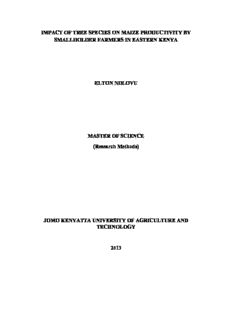
IMPACT OF TREE SPECIES ON MAIZE PRODUCTIVITY BY SMALLHOLDER FARMERS IN ... PDF
Preview IMPACT OF TREE SPECIES ON MAIZE PRODUCTIVITY BY SMALLHOLDER FARMERS IN ...
IMPACT OF TREE SPECIES ON MAIZE PRODUCTIVITY BY SMALLHOLDER FARMERS IN EASTERN KENYA ELTON NDLOVU MASTER OF SCIENCE (Research Methods) JOMO KENYATTA UNIVERSITY OF AGRICULTURE AND TECHNOLOGY 2013 Impact of tree species on maize productivity by smallholder farmers in Eastern Kenya Elton Ndlovu Dissertation submitted to the Faculty of Agriculture in partial fulfillment of the requirements of MSc in Research Methods degree at Jomo Kenyatta University of Agriculture and Technology 2013 DECLARATIONBY THE CANDIDATE This dissertation is my original work and to my knowledge has not been presented for the award of a degree in anyother University. Signature……………………… Date………………………… Ndlovu Elton DECLATION BY SUPERVISORS This dissertation has been submitted for examination with our approval as University and ICRAF supervisors. Signature………………………….. Date……………………… 1. Prof. Kamau Ngamau JKUAT, Kenya Signature………………………… Date……………………… 2. Prof. Catherine .W. Muthuri ICRAF, Nairobi Signature…………………………… Date………………………… 3. Dr. Jonathan Muriuki ICRAF, Nairobi i DEDICATION To all the farmers in Meru and Embu who allowed me to conduct my research work in their farms. ii ACKNOWLEDGEMENTS This research work was conducted with financial support from RUFORUM (Regional Universities Forum) scholarship and ICRAF (World agroforestry Centre). I am so much grateful to the two institutions. I would like to acknowledge the role played by the Jomo Kenyatta University of Agriculture and Technology (JKUAT) in facilitating my studies. I would also like to thank my University supervisor Prof. K. Ngamau, ICRAF supervisors Prof. C.W. Muthuri and Dr. J. Muriuki for their unwavering support during the whole research process. My sincere gratitude also goes to all my friends especially Mcebisi Maphosa, Chester Kalinda, Noella “Nono” Ekhuya, Verrah Akinyi, Gregory Sikumba, Kevin Kenyuira, Grace Mwangi and Maureen Njuguna for their encouragement and help in different ways. Not forgetting my best friend Kaari “Josi” who helped me during data collection and for her encouragement during hard times. The ICRAF staff and students cannot go unmentioned, especially Ms Ndanu Angela, Ms Hellen Ochieng, Joan, Mary Mumbua, Ruth “Wanji,” Vincent “Vinny”, John Nyaga, Lydia, Erick , Peter Gachie and Valentine Gitonga. To all the training unit and Finance staff, thank you folks for your support in different ways. Special thanks also go to Dr. Madakadze, R. and her daughters for hosting me at their home several times. Once again I express my deepest gratitude to my parents for raising me up and teaching me to be patient, my uncles, aunties, brothers and sisters for all the encouragement and support. I extend many thanks to all the farmers in Embu and Meru for their greatest role of allowing me to conduct the research in their farms. I don’t have enough words to thank my greatest iii Provider, Friend, Supervisor, Parent and Guardian the ALMIGHTY GOD; Forever I shall praise him. iv TABLE OF CONTENTS CONTENTS DECLARATION..................................................................................................................i DEDICATION.....................................................................................................................ii ACKNOWLEDGEMENTS...............................................................................................iii LIST OF TABLES...........................................................................................................viii LIST OF FIGURES...........................................................................................................ix LIST OF PLATES...............................................................................................................x LIST OF ACRONYMS......................................................................................................xi ABSTRACT......................................................................................................................xiii CHAPTER ONE..................................................................................................................1 1.0 INTRODUCTION.........................................................................................................1 1.1. Background....................................................................................................................1 1.2. The limitations of the study............................................................................................6 1.3. Statement of the problem...............................................................................................6 1.4. Justification of the study................................................................................................8 1.5. Objectives.......................................................................................................................9 1.5.1. The general objective.......................................................................................................................................9 1.5.2. Specific objectives..............................................................................................................................................9 1.5.3. Research questions.........................................................................................................................................10 CHAPTER TWO...............................................................................................................11 2.0 LITERATURE REVIEW...........................................................................................11 2.1. Challenges faced by smallholder farmers....................................................................11 2.2. Importance of agroforestry in crop production and livelihood of smallholder farmers.................................................................................................................................12 2.2.1. Benefits of agroforestry................................................................................................................................12 2.2.2. Limitations of agroforestry systems........................................................................................................14 2.3. Importance of Maize in Kenya.....................................................................................15 2.4. Challenges in the research process of on-farm studies in Agroforestry.......................16 2.4.1. Importance of on-farm studies in Agroforestry..................................................................................16 v 2.4.2. Setting objectives in an agroforestry research study.......................................................................19 2.4.3. Selection of the study site.............................................................................................................................20 2.4.4. Designing on-farm studies...........................................................................................................................21 2.4.5. Data collection in agroforestry research studies................................................................................23 2.4.6. Handling data analysis...................................................................................................................................23 2.4.7. Sources of variations in on-farm study...................................................................................................24 CHAPTER THREE..........................................................................................................25 3.0 MATERIALS AND METHODS................................................................................25 3.1. Study site description...................................................................................................25 3.2. Sampling procedure......................................................................................................27 3.3. Study design.................................................................................................................29 3.4. Management of plots....................................................................................................32 3.5. Site characterization.....................................................................................................32 3.5.1. Survey on tree species...................................................................................................................................32 3.5.2. Rainfall data collection..................................................................................................................................34 3.6. Soil measurements........................................................................................................35 3.6.1.Soil sampling......................................................................................................................................................35 3.6.2. Walkley and Black titration method for determination of soil organic carbon.....................36 3.6.3. The pH (water) meter method...................................................................................................................37 3.7. Quantitative traits of maize..........................................................................................37 3.7.1. Vegetative growth data on non-destructive measurements (height, diameter)...................37 3.7.2. Chlorophyll content determination in maize.......................................................................................38 3.7.3. Grain yield at maturity...................................................................................................................................39 3.8. Data analysis................................................................................................................40 3.8.1. Tree data..............................................................................................................................................................40 3.8.2. Soil parameters.................................................................................................................................................40 3.8.3. Maize growth and yield.................................................................................................................................40 CHAPTER FOUR.............................................................................................................42 4.0 RESULTS AND DISCUSSIONS...............................................................................42 4.1. The prevalence and distribution of the tree species growing in farms in Eastern Kenya in the long cropping season of 2012........................................................................42 vi 4.2. The influence of different tree species on organic soil carbon in farms in the four study sites at the beginning of the long cropping season of 2012 in Eastern Kenya..........49 4.3. The influence of different tree species on soil pH on farms in the four study sites at the beginning of the long cropping season of 2012 in Eastern Kenya................................53 4.4. The influence of trees species and distance from the tree on maize height and basal diameter at different stages of growth in the long cropping season of 2012 in the four study sites............................................................................................................................56 4.5. Variation of SPAD values with tree species and distance from the tree in maize plants at 6 WACE in the long cropping season of 2012 in the four study sites..................61 4.6. The variations of maize grain yield at physiological maturity, with tree species during the long cropping season of 2012 in Kyeni.............................................................66 4.7. Challenges in research process encountered during the study.....................................69 5.0. Conclusions..................................................................................................................72 6.0. Recommendations and way forward............................................................................73 REFERENCES..................................................................................................................75 vii LIST OF TABLES Table 1.Minimum, maximum and mean values for trunk diameter at breast height ....…33 Table 2. Summary of the most prevalent trees used in agroforestry ..................................46 viii
Description: